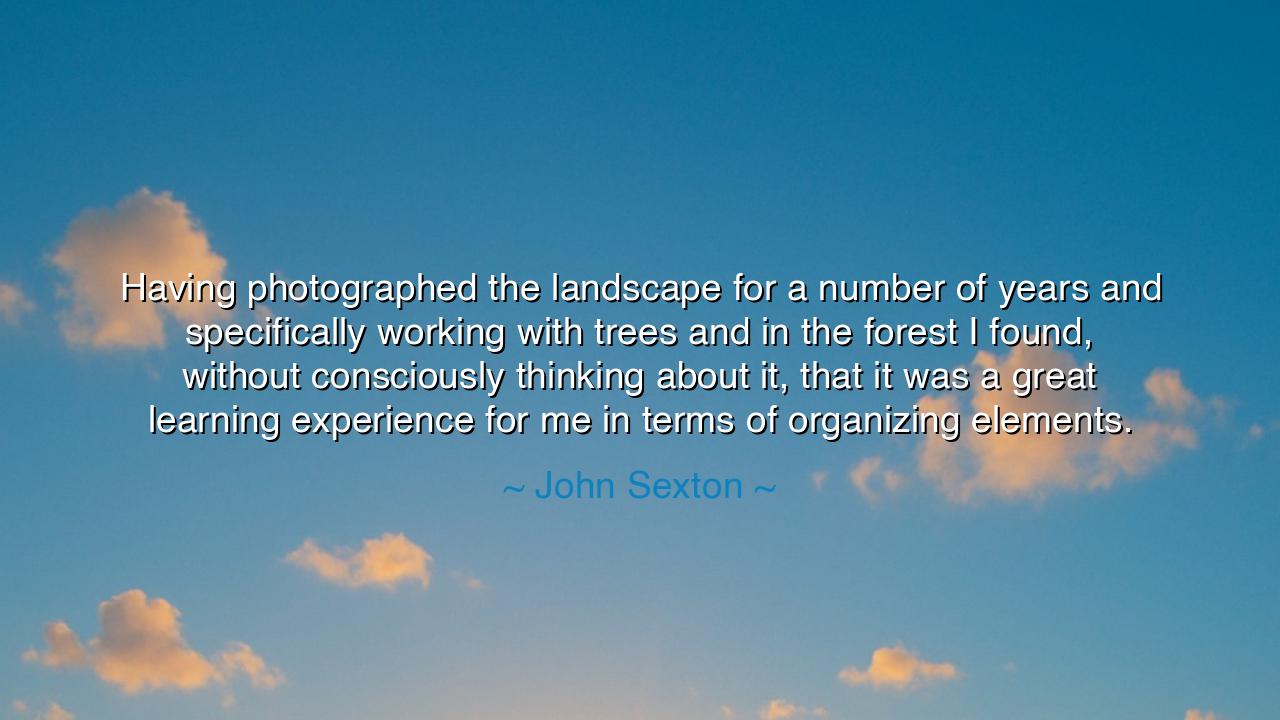
Having photographed the landscape for a number of years and
Having photographed the landscape for a number of years and specifically working with trees and in the forest I found, without consciously thinking about it, that it was a great learning experience for me in terms of organizing elements.






John Sexton, the disciple of light and shadow, once reflected with quiet wonder: “Having photographed the landscape for a number of years and specifically working with trees and in the forest I found, without consciously thinking about it, that it was a great learning experience for me in terms of organizing elements.” His words flow like a stream through the woods, gentle yet profound, revealing the hidden lessons that the natural world whispers to those patient enough to listen. For Sexton teaches us that the forest is not only a subject to be captured, but a teacher that shapes the mind and soul of the artist.
The meaning of this saying rests in the harmony between art and nature. In the landscape, there is order hidden within apparent chaos: branches stretch in countless directions, leaves scatter light into fragments, shadows weave patterns across the earth. Yet, within this seeming disorder, the attentive eye discovers balance. By photographing the trees, Sexton learned the sacred art of arrangement—how to perceive the relationship between form and emptiness, between light and dark, between stillness and movement. This practice became more than photography; it became a meditation on how to organize elements, not only on paper, but in life itself.
The origin of this insight lies in Sexton’s journey as a student of Ansel Adams, where the camera became not merely a tool, but an instrument of vision. Immersed in wilderness, he realized that art does not impose order upon nature, but discovers the order already present. His revelation was not conscious at first—he says he learned “without consciously thinking about it.” This is the wisdom of immersion: that when one lives close to the natural world, lessons seep silently into the soul, shaping perception until one’s very way of seeing is transformed.
History offers echoes of this truth. Consider the Japanese Zen gardens, where monks arranged stones, sand, and trees in deliberate patterns of simplicity. To the untrained eye, such gardens may appear accidental, yet to those with patience, they reveal a deep sense of harmony. The gardener, like Sexton with his camera, learns the eternal lesson: that beauty is not in domination, but in the careful organization of elements, aligning human intention with the natural rhythms of the earth. In both, art emerges not as conquest, but as harmony.
There is something deeply emotional in Sexton’s words, for they remind us that true learning often happens when we are not striving, but simply being. He did not enter the forest with a manual of instruction, but with openness. And in that openness, the trees became his teachers, the shifting light his mentor, the quiet order of the landscape his guide. His discovery was not merely about photography, but about the discipline of perception, the patience to see what lies beneath the surface.
To future generations, this saying carries both guidance and encouragement. The guidance: immerse yourself in the world, not only through books or theory, but through presence and practice. The encouragement: trust that the lessons you most need may come quietly, “without consciously thinking about it,” if you live attentively. Sexton’s experience in the forest is a reminder that wisdom is not only taught—it is absorbed, often in silence, through steady attention to life’s patterns.
The lesson is this: let nature train your eyes, your heart, and your spirit. Practically, this means spending time among trees, watching how shadows fall, how wind arranges leaves, how rivers carve their paths. In daily life, it means applying these lessons of balance and order to your work, your relationships, and your choices. Just as Sexton learned to compose an image by observing the landscape, so too can we learn to compose a life by observing the harmony of creation.
Thus John Sexton’s words endure: “It was a great learning experience for me in terms of organizing elements.” Let all who hear this remember: the forest is not silent, but speaks to those who enter with open eyes. The landscape is not chaos, but a living tapestry, teaching order to those who listen. And if we learn from it, then like Sexton, we may find that the art of nature becomes the art of life, shaping not only our craft but our very way of being.






AAdministratorAdministrator
Welcome, honored guests. Please leave a comment, we will respond soon